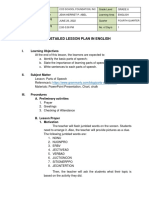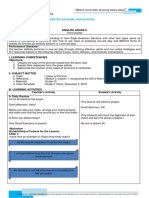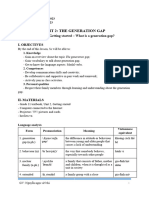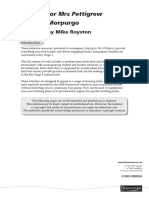LP 4 Feb 22
LP 4 Feb 22
Uploaded by
Erickson John EneroCopyright:
Available Formats
LP 4 Feb 22
LP 4 Feb 22
Uploaded by
Erickson John EneroOriginal Title
Copyright
Available Formats
Share this document
Did you find this document useful?
Is this content inappropriate?
Copyright:
Available Formats
LP 4 Feb 22
LP 4 Feb 22
Uploaded by
Erickson John EneroCopyright:
Available Formats
February 22, 2023
Wednesday
I. LEARNING COMPETENCIES
EN10G-IIIa-31: Use pronouns effectively
Objectives:
At the end of the lesson, the students will be able to:
recall kinds of pronouns
identify cases of pronouns
understand the proper use of pronoun in the sentence
recognize and correct inappropriate shifts in pronoun number and person
II. Subject Matter:
Title: Kinds of Pronouns
Materials: CapSLET, Manila, Marker, Chalk, and whiteboard
Reference/s:
CapSLET Q3 Week 2.2
Using pronouns effectively- https://www.enago.com/academy/use-of-pronouns-in-academic-writing/
Cases of Pronouns: Rules and Examples https://www.gramarky.com/blog/pronoun-cases
Integration: ESP
III. Procedure
Teacher’s Activity Student’s Activity
A. Preliminary Activities (2 minutes)
Greetings
- Good afternoon class... - Good afternoon ma’am, good afternoon
classmates, good afternoon!
- Before you take your seats make sure your
area is clean and your chairs are well arranged. - (Students pick up some trash and arrange
their chairs)
Attendance
- Signed your attendance and pass it one by one. - (Students sign their attendance for the day)
Review
- What did we discuss yesterday?
- Who can define viewing skills?
- Why it is important
Motivation: Pronoun Stickers
Direction: Replace the repeated nouns with the Possible Answers:
correct pronouns.
1. Christine finished the book and returned the 1. it- Christine finished the book and returned
book to the library. it to the library.
2. Roger doesn’t like the city, but Roger 2. he- Roger doesn’t like the city, but he
commutes to the city every day. commutes to the city every day.
3. Lydia enjoys biology and astronomy because 3. both- Lydia enjoys biology and astronomy
biology and astronomy explain many because bothexplain many mysteries to
Lydia.
mysteries to Lydia.
4. When Sue met Ted, Sue noticed that Ted was 4. she, he- When Sue met Ted, she noticed
carrying several books. that he was carrying several books.
5. The parents of the mountain climbers prepared 5. themselves- The parents of the mountain
the parents of the mountain climbers for the climbers prepared themselves for the bad
bad news. news.
ithebothshehethemselvesallouryou
- All your answers are correct! Based on our - We replaced repeated nouns with their correct
activity, what have you observed? pronouns.
- Very Good! Then, what do you think is our topic - Kinds of Pronouns
specifically?
- Perfect! Are you ready to listen? - Yes, Sir!
B. Discussion:(8 minutes)
Pronouns are simple to define but can be confusing
to use. For example, the statement, “Each person
should follow their dreams,” represents a failure to
correctly balance the singular (each person) and the
plural (their dreams). Correcting the statement can be
done in two ways:
Each person should follow his or her dream (to
balance the singular)
All people should follow their dreams (to balance
the plural)
To avoid repetition and use pronouns effectively, we
should remember the different kinds of pronouns and
the way they can be used in a sentence:
Kinds of Pronouns
1. Personal Pronouns- are pronouns that we use
to refer to people and, sometimes, animals
I, you, he, she, it, we, they
Example: I call to see him today.
2. Demonstrative Pronouns- are used to point
to specific things.
this, that, these, those
Example: This is my favorite shirt.
3. Relative Pronouns- connect dependent
clauses to independent clauses.
who, whom, which, whoever, whichever
Example: I need to find a person who can read
Swedish.
4. Reflexive Pronouns- Reflect back to someone
or something in a sentence.
Myself, yourself, himself, itself, themselves,
yourselves
Example: John decided to reward himself with
a dinner out.
5. Interrogative Pronouns- Ask questions
Who, what, when, where, how
Example: What in the world were you
thinking?
6. Indefinite Pronouns- Do not refer to any
person, amount or things in particular
Everything, anything, someone, somebody
Example: Everything was ready for the party.
C. Activity (10 minutes)
- The activity for today will be all about pronouns
and how we use these pronouns correctly in a
sentence.
- I will call random students to formulate a short
sentence with the given type of pronoun.
Direction: Create a short sentence and use the type
of pronoun given to you by the teacher, and use it
as a basis on how you construct your sentence
about how or what you feel about the person you
admire inside the classroom.
- I will call 10 students to answer.
D. Analysis: (7 minutes)
Direction: Answer the following questions as briefly
as possible.
1. What is a Subjective Case?
2. What are the examples of Subjective Case?
3. Give one example of a Subjective Case used in
a sentence.
4. What is Objective Case?
5. What are the examples of Objective case?
6. Give one example of an Objective Case used
in a sentence.
7. What is Possessive Case?
8. What are the examples of Possessive Case?
9. Give one example of a Possessive Case used
in a sentence.
E. Abstraction (3 minutes)
1. What are the kinds of pronouns?
2. What are the cases of pronouns?
I assumed you already understand our topic for today.
F. Generalization: Application (8 minutes)
Direction: A. Tell whether the underlined pronoun
is personal, demonstrative, relative, reflexive,
interrogative, or indefinite.
1. This is my property.
2. He prepared himself for the test.
3. He is the man, who sings songs.
4. How do you know that?
5. Everybody seems ready today?
B. Tell whether the underlined pronoun is
subjective, objective, or possessive.
1. Lanny put the gift under it.
2. Do not forget your responsibility in the group.
3. The teacher gave us a long-range assignment.
4. Place your trophy next to mine.
5. You and I are meant to be.
IV. Evaluation (7 minutes)
Direction: Understand the proper use of pronoun in each sentence. Write your answers on a ½ crosswise.
A. Give the correct pronoun from the options provided in each sentence.
1. He and (me, we, I) will pick out what we’re eating for dinner.
2. He is the writer to (which, whom, whose) the award was given.
3. The book (which, whom, whose) weighed 3 pounds fell off the shelf.
4. Arthur pours a cup of coffee for (herself, himself, itself) every morning.
5. (That, Those, These) is amazing.
B. Replace the underlined word in each sentence with the correct pronoun.
1. Five of ourselves took a cab to the play.
2. Are you and them attending the meeting?
3. A person as young as they should not be given too much responsibility.
4. Who can I go out tonight?
5. The committee told Tan for theyto write a new resolution.
V. Agreement (2 minutes)
Please study your lectures: “Elements of a Story, Listening Skills, Viewing Skills, and Kinds of Pronouns”
for your long quiz on Friday.
Prepared By: Teacher:
Wesly Adrian P. Almonte Mrs. Antonieta Rowena G. Dagoy
ZSCMST Student-Teacher Grade 10- English Teacher
BSED-ENGLISH IV-B
February 22, 2023
Wednesday
VI. LEARNING COMPETENCIES
EN10G-IIIa-31: Use pronouns effectively
Objectives:
At the end of the lesson, the students will be able to:
recall kinds of pronouns
identify cases of pronouns
understand the proper use of pronoun in the sentence
recognize and correct inappropriate shifts in pronoun number and person
VII. Subject Matter:
Title: Kinds of Pronouns
Materials:CapSLET, Manila, Marker, Chalk, and whiteboard
Reference/s:
CapSLET Q3 Week 2.2
Using pronouns effectively- https://www.enago.com/academy/use-of-pronouns-in-academic-writing/
Cases of Pronouns: Rules and Examples https://www.gramarky.com/blog/pronoun-cases
Integration: ESP
VIII. Procedure
Teacher’s Activity Student’s Activity
G. Preliminary Activities (2 minutes)
Greetings
- Good afternoon class... - Good afternoon ma’am, good afternoon
classmates, good afternoon!
- Before you take your seats make sure your
area is clean and your chairs are well arranged. - (Students pick up some trash and arrange
their chairs)
Attendance
- Signed your attendance and pass it one by one. - (Students sign their attendance for the day)
Review
- What did we discuss yesterday?
- Who can define viewing skills?
- Why it is important
Motivation: Pronoun Stickers Possible Answers:
Direction: replace the repeated nouns with the correct
pronouns.
1. Christine finished the book and returned the 6. it- Christine finished the book and returned
book to the library. it to the library.
2. Roger doesn’t like the city, but Roger 7. he- Roger doesn’t like the city, but he
commutes to the city every day. commutes to the city every day.
3. Lydia enjoys biology and astronomy because 8. both- Lydia enjoys biology and astronomy
biology and astronomy explain many because bothexplain many mysteries to
Lydia.
mysteries to Lydia.
4. When Sue met Ted, Sue noticed that Ted was 9. she, he- When Sue met Ted, she noticed
carrying several books. that he was carrying several books.
5. The parents of the mountain climbers prepared 10. themselves- The parents of the mountain
the parents of the mountain climbers for the climbers prepared themselves for the bad
bad news. news.
ithebothshehethemselvesallouryou
- All your answers are correct! So, based on our - We replaced repeated nouns with their correct
activity, what have you observed? pronouns.
- Very Good! Then, what do you think is our topic - Kinds of Pronouns
specifically?
- Perfect! Are you ready to listen? - Yes, Sir!
1. Discussion:(8 minutes)
Pronouns are simple to define but can be confusing
to use. For example, the statement, “Each person
should follow their dreams,” represents a failure to
correctly balance the singular (each person) and the
plural (their dreams). Correcting the statement can be
done in two ways:
Each person should follow his or her dream (to
balance the singular)
All people should follow their dreams (to balance
the plural)
To avoid repetition and use pronouns effectively, we
should remember the different kinds of pronouns and
the way they can be used in a sentence:
Kinds of Pronouns
1. Personal Pronouns- are pronouns that we use
to refer to people and, sometimes, animals
I, you, he, she, it, we, they
Example: I call to see him today.
2. Demonstrative Pronouns- are used to point to
specific things.
this, that, these, those
Example: This is my favorite shirt.
3. Relative Pronouns- connect dependent clauses
to independent clauses.
who, whom, which, whoever, whichever
Example: I need to find a person who can read
Swedish.
4. Reflexive Pronouns- Reflect back to someone
or something in a sentence.
Myself, yourself, himself, itself, themselves,
yourselves
Example: John decided to reward himself with
a dinner out.
5. Interrogative Pronouns- Ask questions
Who, what, when, where, how
Example: What in the world were you
thinking?
6. Indefinite Pronouns- Do not refer to any
person, amount or things in particular
Everything, anything, someone, somebody
Example: Everything was ready for the party.
C. Activity (10 minutes)
- The activity for today will be all about pronouns
and how we use these pronouns correctly in a
sentence.
- I will call random students to formulate a short
sentence with the given type of pronoun.
Direction: Create a short sentence and use the type
of pronoun given to you by the teacher, and use it
as a basis on how you construct your sentence
about how or what you feel about the person you
admire inside the classroom.
I will call 10 students to answer
D. Analysis: (7 minutes)
Direction: Answer the following questions as briefly
as possible.
1. What is a Subjective Case?
2. What are the examples of Subjective Case?
3. Give one example of a Subjective Case used in
a sentence.
4. What is Objective Case?
5. What are the examples of Objective case?
6. Give one example of an Objective Case used
in a sentence.
7. What is Possessive Case?
8. What are the examples of Possessive Case?
9. Give one example of a Possessive Case used
in a sentence.
E. Abstraction (3 minutes)
3. What are the kinds of pronouns?
4. What are the cases of pronouns?
I assumed you already understand our topic for today.
F. Generalization: Application (8 minutes)
Direction: A. Tell whether the underlined pronoun
is personal, demonstrative, relative, reflexive,
interrogative, or indefinite.
6. This is my property.
7. He prepared himself for the test.
8. He is the man, who sings songs.
9. How do you know that?
10. Everybody seems ready today?
B. Tell whether the underlined pronoun is
subjective, objective, or possessive.
1. Lanny put the gift under it.
2. Do not forget your responsibility in the group.
3. The teacher gave us a long-range assignment.
4. Place your trophy next to mine.
5. You and I are meant to be.
IX. Evaluation (7 minutes)
Direction: Understand the proper use of pronoun in each sentence. Write your answers on a ½ crosswise.
G. Give the correct pronoun from the options provided in each sentence.
6. He and (me, we, I) will pick out what we’re eating for dinner.
7. He is the writer to (which, whom, whose) the award was given.
8. The book (which, whom, whose) weighed 3 pounds fell off the shelf.
9. Arthur pours a cup of coffee for (herself, himself, itself) every morning.
10. (That, Those, These) is amazing.
H. Replace the underlined word in each sentence with the correct pronoun.
6. Five of ourselves took a cab to the play.
7. Are you and them attending the meeting?
8. A person as young as they should not be given too much responsibility.
9. Who can I go out tonight?
10. The committee told Tan for theyto write a new resolution.
X. Agreement (2 minutes)
Please study your lectures: “Elements of a Story, Listening Skills, Viewing Skills, and Kinds of Pronouns”
for your long quiz on Friday.
Prepared By: Teacher:
Bernadette J. Partosa Mrs. Antonieta Rowena G. Dagoy
ZSCMST Student-Teacher Grade 10- English Teacher
BSED-ENGLISH IV-A
You might also like
- Nouns Verbs and Adjectives Lesson PlanDocument3 pagesNouns Verbs and Adjectives Lesson Planapi-383717086100% (2)
- DLP - Subject PronounsDocument3 pagesDLP - Subject PronounsKirk Andrade100% (1)
- Lesson Plan English Auxiliary VerbDocument9 pagesLesson Plan English Auxiliary VerbRein MoralesNo ratings yet
- Teaching Demo English DLLDocument10 pagesTeaching Demo English DLLAnne Bernadette Prado Martinez0% (1)
- English 10 Teaching Demo FinalDocument8 pagesEnglish 10 Teaching Demo FinalMj FernandezNo ratings yet
- Cases of Pronouns-LpDocument7 pagesCases of Pronouns-Lphyacinth.cecilleNo ratings yet
- English2 Week5Document5 pagesEnglish2 Week5Julie SoquiñoNo ratings yet
- CASES OF PRONOUNS - Lesson PlanDocument7 pagesCASES OF PRONOUNS - Lesson PlanGedeon YraNo ratings yet
- Parts of Speech Lesson ExemplarDocument4 pagesParts of Speech Lesson ExemplarJean Herriet AbelNo ratings yet
- Unit 2Document31 pagesUnit 2Thùy MạcNo ratings yet
- Review 2Document10 pagesReview 2thucanho1171988No ratings yet
- REVIEW 2,3Document14 pagesREVIEW 2,3cuongNo ratings yet
- DLP Grade 9 Tolentino, Kathy MDocument15 pagesDLP Grade 9 Tolentino, Kathy MKathy TolentinoNo ratings yet
- English4 Q3 PLP WK2Document8 pagesEnglish4 Q3 PLP WK2ellijahvinxhylNo ratings yet
- GerundDocument4 pagesGerundLOIDA ALMAZANNo ratings yet
- Demo Lesson Plan in English 6Document4 pagesDemo Lesson Plan in English 6Susan T.m RamosNo ratings yet
- Unit 7, Lesson 2.2 - GrammarDocument3 pagesUnit 7, Lesson 2.2 - Grammaranhc2k100No ratings yet
- A Detailed Lesson Plan On PrepositionsDocument8 pagesA Detailed Lesson Plan On PrepositionsGyp SyNo ratings yet
- COT 3 EnglishDocument5 pagesCOT 3 EnglishDanny LineNo ratings yet
- Detailed-LessonDocument7 pagesDetailed-LessonAngelica EstadillaNo ratings yet
- giáo án tiếng anh 9 - Unit 1Document37 pagesgiáo án tiếng anh 9 - Unit 1trinhtrongluatNo ratings yet
- DLP Sentence Non SentenceDocument6 pagesDLP Sentence Non SentenceRenz Tyrone Bumagat BenitoNo ratings yet
- DLP Q3W1 Day 4Document8 pagesDLP Q3W1 Day 4Marieta SorianoNo ratings yet
- Sturcture of PlotDocument11 pagesSturcture of PlotJessa Mae MaganNo ratings yet
- Catch Up Friday The Tortoise and The HareDocument5 pagesCatch Up Friday The Tortoise and The HareliezyljaneogaycoNo ratings yet
- Progress Check A - Page 34Document4 pagesProgress Check A - Page 34bboido74No ratings yet
- Unit 10Document48 pagesUnit 10Dương Thị Thanh BìnhNo ratings yet
- Unit 12 - Anh 6Document30 pagesUnit 12 - Anh 6phượng nguyễnNo ratings yet
- DLP - Expanded Definition - Pt. 2Document8 pagesDLP - Expanded Definition - Pt. 2Alexies Jane OlaNo ratings yet
- Semi Detailed Lesson Plan IdiomsDocument7 pagesSemi Detailed Lesson Plan IdiomsIsa Bonni EveNo ratings yet
- LP 03Document5 pagesLP 03Baby DecemberNo ratings yet
- Catch Up Friday The Man and The SerpentDocument4 pagesCatch Up Friday The Man and The SerpentliezyljaneogaycoNo ratings yet
- COT Lesson PlanDocument7 pagesCOT Lesson PlanFhikery ArdienteNo ratings yet
- Diệu Anh. U7. L2.2. GrammarDocument6 pagesDiệu Anh. U7. L2.2. GrammarNguyen Ngoc Thu TrangNo ratings yet
- Unit 8-Anh 11Document37 pagesUnit 8-Anh 11nguyenlegiahungkg123No ratings yet
- Unit 2Document48 pagesUnit 2ThienNo ratings yet
- Unit 2Document48 pagesUnit 2Nguyen Ngoc An ThiNo ratings yet
- Lesson Plan All Summer in A DayDocument16 pagesLesson Plan All Summer in A DayMelay AlmoradoNo ratings yet
- Unit 10Document49 pagesUnit 10TRAN THI KIM NGANNo ratings yet
- Unit 8 FilmsDocument62 pagesUnit 8 FilmsLinh AnhNo ratings yet
- Detailed Lessson Plan in EnglishDocument6 pagesDetailed Lessson Plan in Englishkristen caalimNo ratings yet
- Grade 5: (Eng5-Iiia-7.3.2)Document3 pagesGrade 5: (Eng5-Iiia-7.3.2)Ejaniven Vega Catalan-NatividadNo ratings yet
- Unit 10Document48 pagesUnit 10Nguyễn Võ Tuyết HiềnNo ratings yet
- Lessonplan Gerunds 201028035151Document4 pagesLessonplan Gerunds 201028035151John Kenneth FlorescaNo ratings yet
- GA Tieng Anh 8 Golobal Unit 4Document27 pagesGA Tieng Anh 8 Golobal Unit 4Nguyên Hoàng HảiNo ratings yet
- GA Tieng Anh 8 Golobal Review 2Document8 pagesGA Tieng Anh 8 Golobal Review 2nguyenthingoctuyen14082006No ratings yet
- UNLV Student: PSMT Name: Lesson Plan Title: Lesson Plan Topic: Date: Estimated Time: Grade Level: School Site: 1. State Standard(s)Document9 pagesUNLV Student: PSMT Name: Lesson Plan Title: Lesson Plan Topic: Date: Estimated Time: Grade Level: School Site: 1. State Standard(s)api-297454202No ratings yet
- LP Grammar Grade 7Document6 pagesLP Grammar Grade 7JOANA BELEN CA�ETE JABONETANo ratings yet
- Lesson Plan 2 - Coyote Says RhymeDocument4 pagesLesson Plan 2 - Coyote Says Rhymeapi-659748908No ratings yet
- TA9 - Unit 1Document36 pagesTA9 - Unit 1Quốc Anh TrầnNo ratings yet
- Brilliant Footsteps Int'L Academy Teacher Abdulrahim Ibrahim Lesson Plan & NotesDocument5 pagesBrilliant Footsteps Int'L Academy Teacher Abdulrahim Ibrahim Lesson Plan & NotesAbdulRahimNo ratings yet
- Unit 6 - Lesson 1-4Document17 pagesUnit 6 - Lesson 1-4Nguyen Lan PhuongNo ratings yet
- TA 11-Unit 2Document31 pagesTA 11-Unit 2Hương GiangNo ratings yet
- LP AdverbDocument15 pagesLP AdverbLovely BarreraNo ratings yet
- LP-PronounPrepositionDocument5 pagesLP-PronounPrepositionrosemarydawnf.10No ratings yet
- Semi Detailed Lesson Plan Educ 221Document11 pagesSemi Detailed Lesson Plan Educ 221Adexentrix WPNo ratings yet
- Unit 2 (Chuẩn)Document42 pagesUnit 2 (Chuẩn)Long Thị ThúyLĩnh THPT SỐ 3 LÀO CAINo ratings yet
- A Detailed Lesson Plan in 21 Century Literature From The Philippines and The World Teaching Grade 11Document11 pagesA Detailed Lesson Plan in 21 Century Literature From The Philippines and The World Teaching Grade 11NORZEN LAGURANo ratings yet
- Midter ExamDocument5 pagesMidter ExamErickson John EneroNo ratings yet
- Acitivity 1Document1 pageAcitivity 1Erickson John EneroNo ratings yet
- Final ExamDocument6 pagesFinal ExamErickson John EneroNo ratings yet
- February 28 AutosavedDocument11 pagesFebruary 28 AutosavedErickson John EneroNo ratings yet
- Globalization of Markets and The Internationalization of The FirmDocument18 pagesGlobalization of Markets and The Internationalization of The FirmErickson John EneroNo ratings yet
- Student Teachers Actual Teaching ChecklistDocument2 pagesStudent Teachers Actual Teaching ChecklistErickson John EneroNo ratings yet
- Week 3.2Document1 pageWeek 3.2Erickson John EneroNo ratings yet
- Week 4.1Document1 pageWeek 4.1Erickson John EneroNo ratings yet
- DLP Listening SkillsDocument7 pagesDLP Listening SkillsErickson John EneroNo ratings yet
- Research Final OutcomeDocument18 pagesResearch Final OutcomeErickson John EneroNo ratings yet
- Eng10 Q3 W3 CapsletDocument9 pagesEng10 Q3 W3 CapsletErickson John EneroNo ratings yet
- Eng10 q3 w5 AnswerkeyDocument2 pagesEng10 q3 w5 AnswerkeyErickson John EneroNo ratings yet
- Eng10 Q3 W2 CapsletDocument7 pagesEng10 Q3 W2 CapsletErickson John EneroNo ratings yet
- Eng10 Q3 W4 CapsletDocument9 pagesEng10 Q3 W4 CapsletErickson John EneroNo ratings yet
- Communicative Dictation For Adult Foreign Language Learners in University Academic ContextsDocument11 pagesCommunicative Dictation For Adult Foreign Language Learners in University Academic ContextsGlobal Research and Development ServicesNo ratings yet
- KWL Brainstorm On English LanguageDocument3 pagesKWL Brainstorm On English Languageapi-250303591No ratings yet
- Critical Genre Analysis Investigating Interdiscursive Performance in Professional PracticeDocument5 pagesCritical Genre Analysis Investigating Interdiscursive Performance in Professional PracticeSanando Con AmorNo ratings yet
- Inversion and Emphatic Structures - Adv. GrammarDocument8 pagesInversion and Emphatic Structures - Adv. GrammarПоліна МихалевичNo ratings yet
- Peer Review For First Draft of The Research PaperDocument3 pagesPeer Review For First Draft of The Research PaperJustin HancockNo ratings yet
- Functions of LanguageDocument10 pagesFunctions of LanguageShiela Aringo100% (1)
- In Active Voice Sentences The Subject The Action. in Passive Voice Sentences The Subject The ActionDocument3 pagesIn Active Voice Sentences The Subject The Action. in Passive Voice Sentences The Subject The ActionAnonymous cIHviT5qANo ratings yet
- English I Paper Kalvisolai - Com 23022012.Document30 pagesEnglish I Paper Kalvisolai - Com 23022012.ElanGo YadavNo ratings yet
- Linux Keyboard LayoutsDocument8 pagesLinux Keyboard LayoutsVictor CruzNo ratings yet
- Contextual Variability of Word Meaning by Yasameen KanaanDocument48 pagesContextual Variability of Word Meaning by Yasameen Kanaanmichle 1985100% (1)
- Relative ClausesDocument33 pagesRelative ClausesPachara Pookpanich100% (2)
- Libro Let S Learn English PDFDocument139 pagesLibro Let S Learn English PDFRocio Cco PaNo ratings yet
- The Language of Job PDFDocument16 pagesThe Language of Job PDFEnrico FerlaNo ratings yet
- 2018 RPH Kim English - WK 1Document5 pages2018 RPH Kim English - WK 1LakshmanAmbanasanNo ratings yet
- Pettigrew WebsheetsDocument57 pagesPettigrew WebsheetsJuneNo ratings yet
- Prepositions of PlaceDocument26 pagesPrepositions of PlaceAlexander Martin100% (1)
- Tos English 4Document1 pageTos English 4Val AtienzaNo ratings yet
- Presentation 3Document16 pagesPresentation 3Diego MeraNo ratings yet
- ENG101 Final Term NOTES by VU LearningDocument15 pagesENG101 Final Term NOTES by VU LearningAbdul WahabNo ratings yet
- Prepare Level 6 Pronunciation U1-4Document1 pagePrepare Level 6 Pronunciation U1-4Lisa TrementiniNo ratings yet
- Aphasia: Western Aphasia Battery (WAB)Document13 pagesAphasia: Western Aphasia Battery (WAB)amanda100% (1)
- Semantics: Behaviorism and Context, Culture and StyleDocument4 pagesSemantics: Behaviorism and Context, Culture and StyleDelvi PipiiNo ratings yet
- Direct and Indirect ObjectsDocument2 pagesDirect and Indirect ObjectsAlfian Amin100% (1)
- Biletzki A - Is There A History of PragmaticsDocument16 pagesBiletzki A - Is There A History of Pragmaticsdida13No ratings yet
- Aisatsu (Greetings)Document2 pagesAisatsu (Greetings)johndavid041099No ratings yet
- Pronunciation of Regular Verbs Grammar Drills Grammar Guides Information Gap Acti - 98739Document2 pagesPronunciation of Regular Verbs Grammar Drills Grammar Guides Information Gap Acti - 98739Armando MirandaNo ratings yet
- English Lexicology Morphological Structure of English WordsDocument24 pagesEnglish Lexicology Morphological Structure of English WordsAnglophile123No ratings yet
- VerbsDocument32 pagesVerbsSasikumar SNo ratings yet
- Assignment 3 - Action ResearchDocument23 pagesAssignment 3 - Action ResearchFadzli FaizalNo ratings yet
- UDocument7 pagesUMECHILLE PAY VILLAREALNo ratings yet







































































































